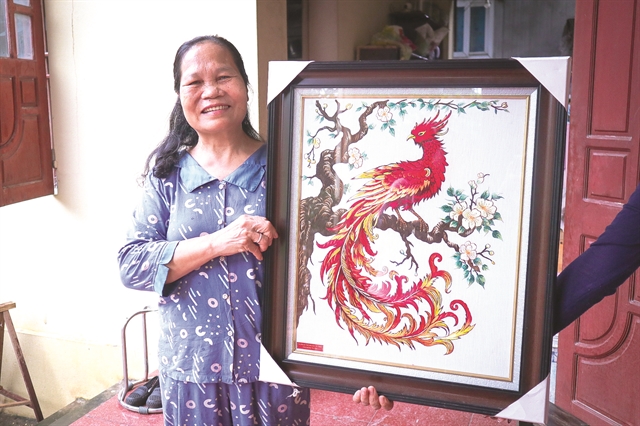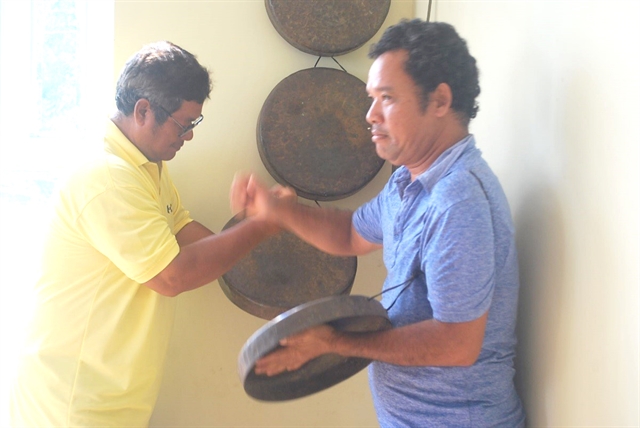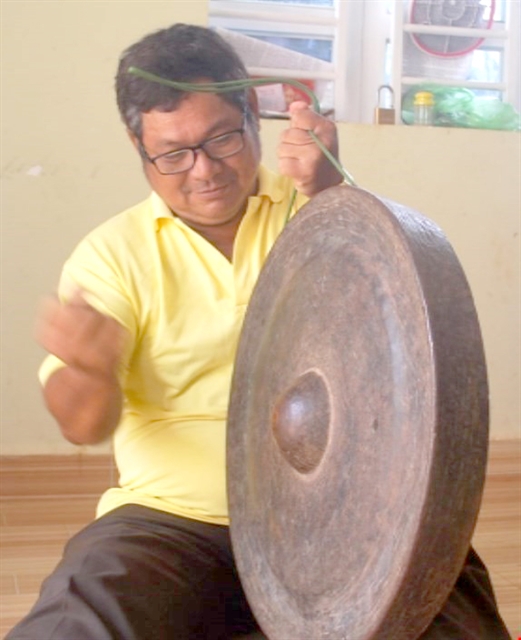 Features
Features

Điểu Huyền Lít from the S’tiêng ethnic minority group in the southern province of Bình Phước’s Long Giang Commune in Phước Long District has been persistent in his efforts to preserve the traditional local gong culture.

|
| EAR FOR TRADITION: Điểu Huyền Lít (left) has led efforts to preserve the local gong culture. - VNA/VNS Photo K GỬIH |
by K GỬIH
While modern life allows for more instances of regional cultural exchange that help enrich national cultural endeavours, specific indigenous cultures remain under threat and are in danger of disappearing if greater care isn’t taken.
Having seen such a situation up close and personal, Điểu Huyền Lít from the S’tiêng ethnic minority group in the southern province of Bình Phước’s Long Giang Commune in Phước Long District has been persistent in his efforts to preserve the traditional local gong culture.
Lít is known among people in the area as the “keeper” of the sound of gongs because of his treasured collection of many types of gongs and knowledge of how they are played.
He views them all as prized property. In his house, which many call a “museum”, Lít has gongs hung carefully and neatly on the walls.
Local people often come to visit and admire the collection, and sometimes passionately perform a traditional dance.

|
| ‘KEEPER’ OF SOUND: Lít has an impressive collection of gongs large and small. - VNA/VNS Photo K GỬIH |
Lít says the gongs are also a form of entertainment for the S’tiêng people and help enrich their spiritual lives.
“The sound of the gongs drives the intellectual, physical, and moral development of the S’tiêng people,” he says.
The S’tiêng are also found in the provinces of Đồng Nai, Lâm Đồng, Bình Dương, Bình Phước, and Tây Ninh, but Bình Phước has the largest population, at nearly 100,000.
Gongs ring out at events such as festivals, weddings, and celebrations for bumper harvests.
They have also been placed as collateral and in marriages are special gifts for the families of both the bride and the groom.
Gongs range in size from 20 to 60cm in diameter, are made of brass, and often accompany singing with harmonious, jubilant, and pulsating rhythms.
S’tiêng villages come to life whenever a gong resounds and the villagers gather together.
Lít said he spent many years searching for and collecting his gongs and also learning how to play them properly. He has two sets in his collection dating back nearly 200 years.
The restoration and preservation of the cultural values of ethnic communities face many difficulties, he explained, and in Long Giang’s case the number of people who can play the gongs is dwindling while young people haven’t been encouraged to appreciate and play them.
“Though there are still some people who can play them well, if the skill is not passed on to the younger generation then a unique part of our culture will be lost,” Lít warns.
Of a similar mind, Điểu Khuy, an experienced gong player who takes part in many local events, says today’s young people pay little attention to the art form.
“I’ve been able to play gongs since I was 10 years old, when it was passed down to me by my family,” he says. “Playing requires passion, while the younger generation lack this emotion and aren’t interested in listening.”
There are some efforts underway to protect the precious gong culture. Trần Thị Phương Trinh, vice chair of the People’s Committee of Long Giang Commune, says Lít’s collection has helped encourage the locals, especially the youth, to preserve the value of the communal culture.
Local authorities, she explains, have fully supported community efforts by helping the village set up teams of gong performers that include younger people.
“The village now has its own gong ensemble that plays at local events, like festivals, meetings, and conferences,” she says. “We do our best to support them where we can,” Trinh says.
She adds that the communal People’s Committee is conducting programmes to increase awareness among local people about the importance of preserving traditional customs and culture as the modern world takes hold.
She also appeals for individuals and organisations to come together and preserve and promote the unique ethnic cultural characteristics in the commune.
It’s widely believed that gongs create a connection between the living and the supernatural, with each one housing a deity whose power corresponds to the gong’s age, according to cultural researchers.
This notion, though, has been affected by rapid economic and social development that has disrupted the passing down of traditional knowledge and stripped the gongs of their spiritual significance.
Gongs are closely associated with life in the central highlands and large swathes of the southern region. They are considered the voice of the spirits and part of the human soul, with the purpose of expressing joy and sadness in life and work.
They are made of copper alloy, sometimes mixed with gold, silver, or bronze. Two to thirteen gongs are played by village ensembles, which consist of both men and women.
Research has shown that gongs are “descended” from the lithophone -- an ancient musical instrument with 11 slabs of stone. In national cultural history, they have been played to celebrate a new and prosperous rice season and to express the sacred belief in communicating with supernatural powers.
In the most important festivals for ethnic minority people, from an infant’s ear-blowing ceremony to mourning rituals and buffalo sacrifices, the sweet melody of gongs plays an undeniable role in connecting people within the same community. - VNS




